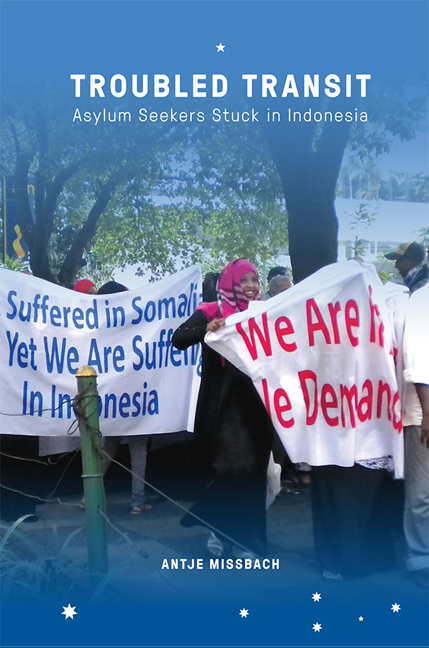Book contents
- Frontmatter
- Contents
- List of tables
- Acknowledgements
- Map of Indonesia
- Acronyms and Initialisms
- 1 Introduction
- 2 Transiting Indonesia: Past and Present
- 3 The Politics of Detention
- 4 Life on Hold
- 5 The Limits of Protection
- 6 Indonesia as a Transit State: Obligations, Policies, and Practice
- 7 Tidal Ebb and Flow: The Indonesia-Australia Relationship
- 8 Selling Hope
- 9 Conclusion
- Bibliography
- Index
- About the Author
2 - Transiting Indonesia: Past and Present
Published online by Cambridge University Press: 19 May 2017
- Frontmatter
- Contents
- List of tables
- Acknowledgements
- Map of Indonesia
- Acronyms and Initialisms
- 1 Introduction
- 2 Transiting Indonesia: Past and Present
- 3 The Politics of Detention
- 4 Life on Hold
- 5 The Limits of Protection
- 6 Indonesia as a Transit State: Obligations, Policies, and Practice
- 7 Tidal Ebb and Flow: The Indonesia-Australia Relationship
- 8 Selling Hope
- 9 Conclusion
- Bibliography
- Index
- About the Author
Summary
It is already clear that the Government of Indonesia cannot
assist refugees to stay in Indonesia. Indonesia is only willing
to help refugees to continue their journeys to a third country.
From the perspective of humanitarianism we offer
assistance when needed.
(Indonesian Department of Information 1980, p. 2)
The transit of people through Indonesia is not a new phenomenon. Because of its geographic configuration and location, Indonesia, an archipelago with more than 17,000 islands linking Asia and Australia, has always attracted migratory movements. The impacts of foreign influence in the archipelago, some temporary, some permanent, are widely visible in its languages, customs, architecture and many other aspects of society.
This chapter investigates what it has meant to be a transit migrant in Indonesia in the recent past. First, attention is given to Indonesia's experiences with Indochinese (mainly Vietnamese) transit migrants between the late 1970s and the mid-1990s. By outlining the political constellations that led to the establishment of the refugee processing centre on Galang Island in 1979, the reasons why the Indonesian government agreed to receive transit migrants temporarily are explained. Shedding light on daily life on Galang Island helps clarify reasons for the use of island camps as a special tactic in migration control, or, in Alison Mountz's words, as a “broader enforcement archipelago of detention” (Mountz 2011a, p. 118).
Using official UNHCR reports, witness accounts and other sources, the chapter provides an overview of the general conditions on the island that became a temporary home for tens of thousands of Vietnamese, many of whom stayed there much longer than expected. Although hundreds of thousands of Vietnamese were resettled in the West, subsequent flows continued to crowd the regional refugee camps. Given the reluctance of Thailand, Malaysia, Singapore and Indonesia to become permanent settlement destinations, the international community, under the auspices of the UNHCR, agreed on the Comprehensive Plan of Action (CPA) in 1989. The CPA put an end to the outflow of people from Vietnam by implementing for the first time a new scheme for determining refugee status and by relying on both voluntary and forced repatriation of those who did not qualify as genuine refugees. Despite the forced returns, the CPA is still heralded as a great success in UNHCR-led international refugee cooperation (Betts 2006).
- Type
- Chapter
- Information
- Troubled TransitAsylum Seekers Stuck in Indonesia, pp. 29 - 60Publisher: ISEAS–Yusof Ishak InstitutePrint publication year: 2015

